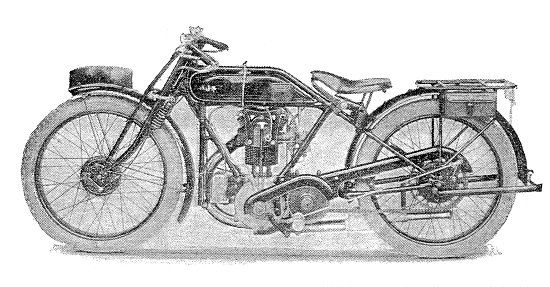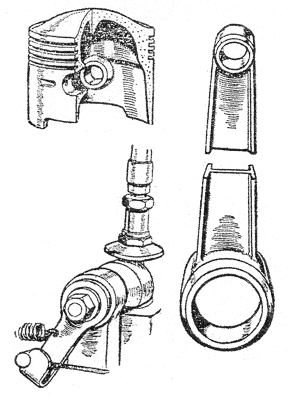|
Overhead Valve A.J.S. Available
New 349c.c. model based on famous
T.T. winning type
More than once
criticisms have been heard owing to
the fact that the makers of the
A.J.S. have repeatedly won the
Tourist Trophy race with an overhead
valve model which was not available
on the open market.
Nevertheless
the manufacturers acted wisely, for
they thought that until the
experimental machines had been
reduced to a form in which they were
safe in the hands of the public, it
was better not to sell them
broadcast. Now, however, the latest
developments render the o.h.v. model
as available as the popular side
valve type.

A new A.J.S. model which is
practically a replica of the
successful T.T. machine.
At the
forthcoming Olympia Show there will
be staged a super sports model with
an engine based on the T.T. A.J.S.
machine. The overhead valve
mechanism will be almost exactly
similar, except for the fact that
somewhat longer valve guides are
employed so as to reduce wear at
this vital point. These valves give
a clear port opening equivalent to
one and nine sixteenths inches, and
a lift of five sixteenths of an
inch. They are operated through
hollow push rods with an independent
return spring for the rocker gear.
Recent modifications include an
increased heads cooling area with
vertical fins arranged to lie in the
same direction as the main air
current. The detachable head is held
down by a round section steel strap,
semi-circular in form. As might be
expected, the head and cylinder
joint are formed on the patented
A.J.S. lines.
Four-ringed aluminium piston
Another
innovation since the Tourist Trophy
races takes the form of an aluminium
piston, though the four very narrow
rings above the gudgeon pin are
retained. A hollow gudgeon pin is
fixed in the piston bosses by means
of a split pin, a bronze bush being
fitted to the small end of the
connecting rod; the connecting rod
itself is a nickel chrome forging,
heat treated and machined all over.
The section of the road is
extraordinarily light, being no more
than one sixteenth of an inch thick
in the web; in spite of this, no
trouble has ever been experienced
with it. Two rows of five sixteenths
of an inch rollers are employed for
the big end, an outer race being
pressed into the rod. The bore and
stroke remain as before, 74 x 81 mm,
349c.c.

Top:
aluminium piston in the
o.h.v. engine.
Left: neat
external valve lifter
cam.
Right: the roller
bearing in the big end
of the
light connecting rod is
carried in a
pressed-in bush. |
Plain splash lubrication
is relied upon for the
bronze main bearings. On
the driving side of the
crankshaft a standard
spring loaded cam type
of shock absorber is
fitted, transmission
following standard
A.J.S. lines through a
close ratio gearbox, the
ratios supplied being 5
to 1, 6.1 to 1, and 9.4
to 1.
For
the benefit of sporting
riders who desire to
enter speed events and
hill climbs, the rear
mudguard and carrier
have been made in
quickly detachable form.
There is also a stay
from the saddle tube to
the rear of the cylinder
head.
This overhead valve
model does not replace
the standard
side0-by-side valve
machine, which is still
listed as before, but
with 650 x 65 mm tyres,
modified handle bars and
a much improved front
mudguard which, in
addition to being
splayed at the rear, is
formed with mud-trapping
channels round the edge
of the valences, and a
shield at the front to
prevent the ingress of
air, which usually blows
back mud spray onto the
rider. An aluminium
piston is also fitted to
this model.
Such features as the
adjustable foot rests,
neat knee grips fixed
direct to the tank, the
spring loaded hand oil
pump, are of course
retained, and the
machine is finished as
well as ever. |
Modifications
to the 799c.c. passenger outfit
consists of aluminium pistons, and a
similar but enlarged type of
mudguard to that employed on the
standard 349c.c. model, the fitting
of a Lucas Magdyno and lamps are
standard, and the arrangement of the
change speed lever and switchbox
further forward on the tank, so that
they clear the rider’s knee with
comfort. |